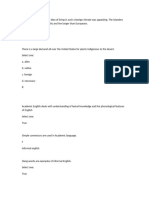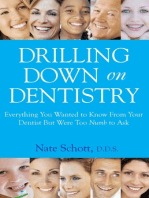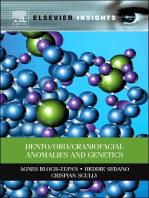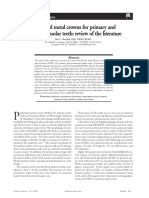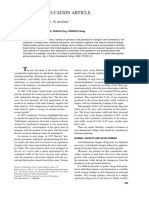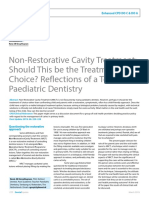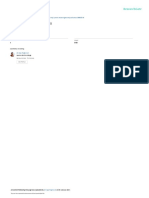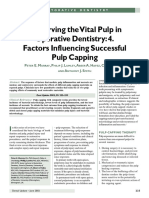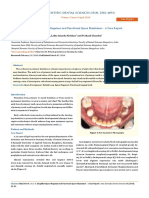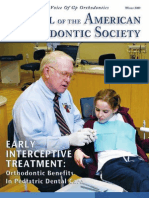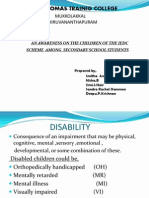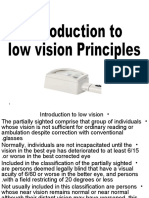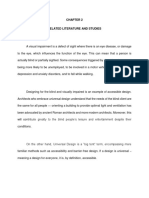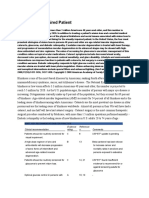Professional Documents
Culture Documents
3D Braille As Media in Improving Tooth Brushing Skill For Blind Children
Original Title
Copyright
Available Formats
Share this document
Did you find this document useful?
Is this content inappropriate?
Report this DocumentCopyright:
Available Formats
3D Braille As Media in Improving Tooth Brushing Skill For Blind Children
Copyright:
Available Formats
Volume 5, Issue 6, June – 2020 International Journal of Innovative Science and Research Technology
ISSN No:-2456-2165
3D Braille as Media in Improving
Tooth Brushing Skill for Blind Children
Fastabiqul Hanif1*, Lanny Sunarjo2, Bedjo Santoso3, Masrifan Djamil4, Ari Suwondo5 Dyah Fatmasari6
1, 2, 3,4, 5, 6
Poltekkes Kemenkes Semarang, Dental Therapist and Hygienist,
Tirto Agung Rd., Semarang Jawa Tengah 50268, Indonesia
Abstract:- The problem experienced by blind children is status, growth and weight of children[6]. More than 50
that difficult to do self-activity especially in behavioral million hours per year are lost due to children are often
dental and oral health care. One of the behavioral absent for school because of dental and oral health
change strategies for blind children is through dental problems. This makes the intellectual level of the child
and oral health education with counseling activities decreases if it continues lead for a long time[7].
which should put attention to the characteristics of the
blind child as well as utilize the hearing and touch Daily tooth brushing behavior in normal children in
senses by implementing 3D Braille Media. It is a Indonesia is 94.7% yet the proper toothbrushing percentage
development of 3D printing media comprising is only 2.8%. Meanwhile the daily tooth brushing behavior
procedure of proper tooth brushing. The aim of this in Central Java, Indonesia is 94.6%, but in contrast, the
research is to create 3D Braille as a media of learning to proper brushing teeth behavior is just 1.7 %.[8].
improve tooth brushing skills for blind children. We
implemented Research and Development (R & D) Based on the results of a preliminary study in one of
method which has five stages of research: data SLB (Special Education School) in Indonesia precisely in
collection, design and build, expert validation, model Jepara regency, Central Java, as much as 40% of tooth
test and model result. It’s performed in the Quasy brushing activities are carried out by blind children in the
experiment pre-test and post-test with control group morning or in the afternoon bathing. The blind children who
design sample divided into 2 groups, of which 15 blind like cariogenic food is 73% and proper tooth brushing
children were in intervention group using 3D Braille technique percentage is only 7%.
media and 15 blind children were in control group using
Braille flipcharts. The data used intraclass corellation Either clinical or non-clinical factors can influence the
coeffiecient test, paired and independent sample caries of permanent tooth. One of the most dominant
test. The results show that 3D Braille is worthy of a contributing factors is behavior and OHI-S (Oral Hygiene
learning media about tooth brushing with p-value of Index Simplified). Therefore, a plan for overcoming the
0.000. Besides, it is more effective in improving tooth problem is by promotive and preventive activities[9]. Efforts
brushing skills with p-value of 0.002, as well as lowering to improve the degree of dental and oral hygiene of blind
the index debris with p-value of 0.020. According to the children is on behavioral change, because behavior is a
results of the research, it can be inferred that the factor that affects awareness in taking care of dental and oral
impementation of 3D Braille Media model is more hygiene. Knowledge influences dental and oral hygiene,
effective in improving the tooth brushing skills and attitude as well as skills. In addition, it also affect the status
lowering the index debris compared to Braille of dental and oral hygiene. Behavior change strategies is in
flipcharts. form of strength, law, and education[10][11].
Keywords:- 3d Braille, Blind Children, Tooth Brushing One of the behavioral change strategies for blind
Skills. children through dental and oral health education is with
counseling activities. However, the method has to be
I. INTRODUCTION adjusted with respect to the condition of blind children.
Children with blindness have limited sense of sight so it is
Children with blindless have a high level of caries and difficult to recognize an object visually in the learning
poor oral and dental hygiene compared to normal children process. Blind children rely on the sensitivity of the sense of
[1][2]. The prevalence of caries in blind children in the touch. The way to utilize their sense of touch is by using
world, one which stands high is in India with 60% braille letters. Braille is a tactile writing system used for
percentage. Nevertheless, in Indonesia, the caries prevalence blind children. Traditionally, these letters have been
reach more up to 80.6%[3][4]. Not to mention, the embossed on paper. The blind know and easily understand
prevalence of dental and oral hygiene in blind children in braille writing because they are accustomed of reading
India is 40%, while Indonesia strikes to 50%[5]. Globally, braille writing. This makes dental and oral health education
dental caries has a higher impact on quality of life due to more easily accepted[12][13].
pain in the oral cavity and reduction of oral cavity function
for communication and as a tool for digestion. The more the Braille media has been applied in Indonesia to improve
number of teeth lost, the lesser the cognitive and memory the dental and oral hygiene. Nevertheless, the media only
function. Chronic caries is known to affect the nutritional introduces letters to blind children so that they are less able
IJISRT20JUN964 www.ijisrt.com 1414
Volume 5, Issue 6, June – 2020 International Journal of Innovative Science and Research Technology
ISSN No:-2456-2165
to recognize the whole object of picture. The recognition of media for blind children as replication based on
braille arising picture, allows blind children to feel the shape Notoadmojo, Maher and Roger's theories.
of objects and recognize visual picture quickly so that it
helps the development of tactile sharpness and mobility of C. Expert Validation
children as well as their feeling to sense and feel the
ambience[14][15]. Expert Validation
n f(%) p-value
According to the background and problem, a 3D Relevant 10 100
braille becomes an urge to be created in order to improve 0,000
Irrelevant 0 0
the skill of toothbrushing in blind children. It is a * Intraclass correlation coefficient
development of 3D Printing media where procedures of Table 1:- 3d braille Statistical test validation from the
proper brushing are provided to stimulate the attention, expert
interests, thoughts and feelings of blind children to begin
improving their tooth brushing skills. 3D braille media Table 1 show the 3D braille statistical test validation
model trains the hands and mind coordination of blind from the expert which indicates the p-value score is in
children besides reading dental and oral hygiene messages 0.000, which means that the 3D Braille model is relevant
on it. Also, there are 3D printed-object so that what they and suitable as a media to improve the skill of tootbrushing
read is conveyed through these picture-object. in blind children.
II. METHODOLOGY D. Model Test
The research methodology is Research and No Variable p-value*
Development (R&D), which is used to produce a product Intervention Control
and test the effectiveness of it. The Research and Blind children (n=15)
Development (R&D) procedure consists of 5 main steps, Pre-test skill 0,960 0,331
namely data collection, design and build, expert validation
Post-test skill 0,930 0,363
and revision, model test, and model results[17].
Pre-test debri index 0,150 0,880
Post-test debri index 0,140 0,721
The research design was quasy experiment (pre and
*Shapiro-wilk
post-test with control group design). This research was
Table 2:- Data Normality Test For Blind Children
carried out in SLBN (State Special Education School)
Semarang, Indonesia as an intervention group and SLBN
Table 2 shows the data normality test for blind children
(State Special Education School) Jepara, Indonesia as a
control group. The sampling technique was purposive as the respondents. Normality test results show that the p-
value is more than 0.05, so it wrapped that the data are
sampling with 30 children divided into two groups, 15
normally distributed so it can be continued using the
children in each intervention group and the control group.
Research data using ratio scale. Intraclass correlation parametric test.
statistical test was implemented to determine the feasibility
of the model, while the normality test used the Shapiro
Wilk test regarding the number of respondents is less than
50. The effectivity test on the paired group normal data
used dependent sample test and for the unpaired group, it
used the independent sample test.
III. RESULTS AND DISCUSSION
A. Data Collection
The results of data collection conducted through
interview method and Systematica Literature Review
concluded that to improve the skill of tooth brushing in *paired sample test
blind children, it needs learning method and media adapted Table 3:- Paired-Data Effectivity Test
to the characteristics of blind children by utilizing the senses
of hearing and touch. Table 3 shows theh paired-data effectivity test. The
effectivity of the data test on the skill of tooth bruhsing in
B. Design and Build blind children show that the p-value of the intervention
The result from data collection is used to produce the group is 0.000 which is less than 0.05, meaning that the 3D
model design. The results of information revealed that blind braille media model is effective in increasing the skill of
children cannot independently take care of their dental and tooth brushing. The p-value of the control group is 0.000 (p
oral hygiene. So the researchers made a 3D Braille media <0.05), meaning that the braille flipchart media and tooth
model with respect to the needs of method and learning brushing demonstration are effective in improving the
brushing skills of blind children.
IJISRT20JUN964 www.ijisrt.com 1415
Volume 5, Issue 6, June – 2020 International Journal of Innovative Science and Research Technology
ISSN No:-2456-2165
Same results also occur on the effectivity test of debris IV. DISCUSSION
index, which show that the p-value of the intervention group
is 0.000, in which p-value is less than 0.05, meaning that the 3D braille media model was performed to blind
3D braille media model effectively reduces the debri index. children in addition to learning media as well as to improve
The p-value of the control group is 0.000 (p <0.05), the skill of toothbrushing and reduce the debris index. The
representing that the flipchart braille media and tooth skill of tooth brushing has increased because 3D braille
brushing demonstration are effective in reducing the debris media have many advantages. There are stimuli, triggering
index of blind children. thoughts, attractiveness, creativity that makes them
understand their brushing skill because the media take the
Variabel Unpaired-data test * role of blind children in terms of hearing and touching
n Mean±SD Delta P-Value senses. In the learning process, the education was carried
out 10 minutes before the learning hours in small groups
Skill
according to their respective classes. The children are
Intervention 15 17,47± 2,200 directly involved demonstrating on how to brush their teeth
3,20 0,002
Control 15 14,27±2,815 properly. This is consistent with the theory of Stimulus-
Debris Index Organism-Response (SOR) behavior change which states
that behavior change depends on the stimulus or stimulus
Intervention 15 0,840±0,462
0,52 0,020 provided.
Control 15 1,360±,0,674
*Independent sampel test Blind children could express their motivation in this
Table 4:- non-paired data effectivity test learning method, besides, small group discussion was more
effective in improving dental and oral hygiene compared to
Table 4 shows the non-paired data effectivity test. The large group[18], as well as the implementation of
effectivity test on the skill of toothbrushing of blind toothbrushing was also implemented on day 1 to 10 (2
children show that the p-value is 0.002 (p <0.05), meaning weeks). The practice of brushing was done in the school
that the 3D braille media model is more effective in yard according to the group. Each group was accompanied
increasing brushing skill compared to flipchart braille by their class teacher. In the second week, the children
media and tooth brushing demonstration. began to show changes on their way to brush their teeth. A
child's direct involvement, in fact, can improve tooth
The effectivity test on debris index for blind children brushing skill[19]. Stage by stage has made a significant
shows that the p-value is 0.020 (p <0.05), meaning that the change in the intervention group because to change a
3D braille media model is more effective in reducing debris person's habit, it requires a constant period. Steady learning
index for blind children compared to flipchart braille media on toothbrushing will change someone's behavior
and tooth brushing demonstration. better[20].
E. Model Result The debris index of blind children has decreased
The result of the model is 3D braille media which is because the sample has been taught to understand the
the outcome from the development of counseling method practice of brushing the teeth properly. Correct and proper
and innovative media for tooth brushing by exploiting the tooth brushing practices can get rid of plaque and
senses of hearing and touch and in accordance with the debris[21]. The practice of proper tooth brushing will
characteristics of blind children regarding the improve the dental and oral hygiene of blind children[22].
implementation of 3D braille media model guided by the Basically, the intelligence ability of a blind child is the
school teachers. same as a normal child. Yet, if the skill of tooth brushing in
blind child is lacking, it will affect their own dental and
oral hygiene.
The 3D braille model is stated to have succeeded in
changing the habit of toothbrushing in blind children. It can
be seen because 10 days afterwards, the blind child
continued to brush their teeth after school break and the
blind children are able to do it properly. Consequently, the
debri index is decreased. The success of 3D braille is due to
the fact that the implementation has been carried out for 10
days to provide more stimulus in the learning process by
involving the teacher in guiding and assisting children in
brushing their teeth.
Fig 1:- 3D Braille Media
IJISRT20JUN964 www.ijisrt.com 1416
Volume 5, Issue 6, June – 2020 International Journal of Innovative Science and Research Technology
ISSN No:-2456-2165
V. CONCLUSION [12]. E. Mardiati, Salikun, and K. Aprianti, “the
Effectiveness of Audio Media and Braille Leaflet
3D Printing development triggers the idea of this Media on the Knowledge of Maintaining Oral
research in 3D Braille model for dental and oral hygiene Hygiene Among Blind Children,” J. Kesehat.
learning for Special Education School’s students, Gigi,2018, vol. 5, no. 1, p. 61,.
particularly blind children. Adapting the senses of hearing [13]. T. Mahantesha, A. Nara, P. R. Kumari, P. K. N.
and touching, 3D Braille model successfully proven that it Halemani, V. Buddiga, and S. Mythri, “A comparative
is more effective in improving the toothrushing skill of evaluation of oral hygiene using Braille and audio
preschool children than another same method with flipchart instructions among institutionalized visually impaired
without feature of voice indicating the picture-object children aged between 6 years and 20 years: A 3-
message. monthfollow-up study.,” J. Int. Soc. Prev. Community
Dent., 2015, vol. 5, no. Suppl 2, pp. S129-32.
REFERENCES [14]. D Fatmasari, FM Sabilillah, RZ Tafzani, Y Sopianah,
“Effect Of Braille Education (DBE) On Oral Hygiene
[1]. Kemenkes, “Child health care guidelines in schools In Child Blind Preface”, J. Kesehat. Gigi, 2016,vol.
are excellent (SLB),” 2010. 03, no. 2,.
[2]. M. Jain, S. P. Bharadwaj, L. S. Kaira, D. Chopra, D. [15]. A. Stangl, J. Kim, and T. Yeh, “3D printed tactile
Prabu, and S. Kulkarni, Oral Health Status and picture books for children with visual impairments: A
Treatment Need Among Institutionalised Hearing- design probe,” ACM Int. Conf. Proceeding Ser, 2014,
Impaired and Blind Children and Young Adults in no. June, pp. 321–324,.
Udaipur , India . A Comparative Study," A [16]. M Sugiyono, Research and Development
comparative Study OHDM 2014. (R&D).Bandung: Alfabeta, 2015.
[3]. M. Choirunnisa, P. Agusmawanti, and M. Yusuf, [17]. M. Siskawati, P. Pargito, P. Pujiati, “Development of
“Fones To Decrease Dental Plaque Index In Children Monopoly learning Media to increase learning interest
With Blind Age 6-13 Years In Semarang,” Odonto in student geography,” J. Stud. Sos,2016 vol. 4, no. 1,
Dental Journal, 2015, vol. 2, pp. 36–40. pp. 72–80,.
[4]. BE Marimbun, CN Mintjelungan, DHC Pengemanan, [18]. D Fatmasari, YR Ramadhani, EA Ekoningtyas, T
“Knowledge level relationships on dental and oral Wiyatini, "Salivary Glucose Level Increases Severity
health with dental caries status in the visually Of Periodontal Condition In Patients With Type 2
impaired” vol. 4, pp. 0–5, Jurnal e-Gigi,2016. DM" Public Health Journals of Unnes,” 2019, vol. 8,
[5]. D. Agnintia, F Rachmawati,R Arsita, PL Berti, " no. 1, pp. 178–184,.
Quality Self Care And Home Care Solution Dental [19]. C. Ganss, N. Schlueter, S. Preiss, and J. Klimek,
Health and mouth blind child at Sdlb A-Ykab “Tooth brushing habits in uninstructed adults -
Surakarta,” Odonto Dental Journal, 2013. Frequency, technique, duration and force,” Clin. Oral
[6]. A. Hamid, D. Wijaya, Z. Sulaiman, and I. Ismalayani, Investig., vol. 13, no. 2, pp. 203–208, 2009.
“Quality of life children aged 3-5 years with Early [20]. F. Schwendicke, A. M. Jäger, S. Paris, L. Y. Hsu, and
Chilhood Caries unhandled,” J. Kesehat. Y. K. Tu, “Treating pit-and-fissure caries: A
Gigi,2019,vol. 6, no. 1, p. 14. systematic review and network meta-analysis,” J.
[7]. B. Santoso, N. Gejir, and D. Fatmasari, “Information Dent. Res., vol. 94, no. 4, pp. 522–533, 2015.
System Monitoring Model Implemented in School [21]. M. R. Bishop, A. L. Kenzer, C. M. Coffman, C. M.
Health Dental Unit,”ARC Journal of Dental Science, Tarbox, J. Tarbox, and T. M. Lanagan, “Using
2017, vol. 2, no. 4, pp. 8–11,. stimulus fading without escape extinction to increase
[8]. Riskesdas,“Riskesdas Main Results 2018,” compliance with toothbrushing in children with
http://www.depkes.go.id/article/view/18110200003/po autism,” 2013, Res. Autism Spectr. Disord., vol. 7, no.
tret-sehat-indonesia dari-riskesdas-2018.html. 6, pp. 680–686.
[9]. L Sunarjo, Salikun, PW Ningrum “Factors causing [22]. H. Y. Liu, CC Chen, WC Hu, RC Tang, CC Chen,
high numbers of dental caries remained on elementary Tsai CC, ST Huang., “The impact of dietary and
school students 02 Banjarsari District Talun District of tooth-brushing habits to dental caries of special school
Pekalongan Regency,” Jounal ARSA, 2016, vol.1, pp. children with disability,” 2010, Res. Dev. Disabil.,
22–28,. vol. 31, no. 6, pp. 1160–1169.
[10]. B Sutomo , B Santoso, NA Maula “Influence of
parents 'behaviour on the Status of children's dental
hygiene at SDN 03 Karangjati,” J. Kesehat. Gigi,
2017, vol. 04, no. 2, pp. 21–26.
[11]. I. Wiradona, B. Widjanarko, and B. M. Syamsulhuda,
“Influence of tooth brushing behaviour on dental
plaque in grade IV and V students at SDN.
Gajahmungkur District of Semarang,” Health
Promotion Journals,2016,vol. 8, no. 1, pp. 59–68,.
IJISRT20JUN964 www.ijisrt.com 1417
You might also like
- First Quarter Exam ReviewerDocument46 pagesFirst Quarter Exam ReviewerMary April Repuela Gapo100% (1)
- Pediatric Dentistry Lab Manual and Clinical GuideDocument99 pagesPediatric Dentistry Lab Manual and Clinical GuideJames MonroeNo ratings yet
- Management of Deep Carious Lesions in ChildrenDocument46 pagesManagement of Deep Carious Lesions in ChildrenSahil Gagnani100% (1)
- Methods of Evaluation of AirwayDocument62 pagesMethods of Evaluation of AirwayRazeev MishraNo ratings yet
- Role of Tongue in MalocclusionDocument81 pagesRole of Tongue in MalocclusionmeghaNo ratings yet
- Logmar Bailey-Lovie ChartDocument14 pagesLogmar Bailey-Lovie ChartristaniatauhidNo ratings yet
- Cementoenamel Junction InsightsDocument6 pagesCementoenamel Junction InsightsJessica ChenNo ratings yet
- Stainless Steel CrownDocument12 pagesStainless Steel CrownAndreas WallaceNo ratings yet
- Nonvital Pulp Therapy in Primary TeethDocument15 pagesNonvital Pulp Therapy in Primary TeethJose RoldanNo ratings yet
- Oral Wound Healing: Cell Biology and Clinical ManagementFrom EverandOral Wound Healing: Cell Biology and Clinical ManagementHannu LarjavaNo ratings yet
- Bj-Rndal Et Al-2019-International Endodontic JournalDocument25 pagesBj-Rndal Et Al-2019-International Endodontic JournalAnnabella Natasha100% (1)
- Indirect and Direct Pulp Capping: Reactionary vs. Reparative DentinsDocument6 pagesIndirect and Direct Pulp Capping: Reactionary vs. Reparative Dentinshafizhuddin muhammadNo ratings yet
- Vital Pulp TherapyDocument10 pagesVital Pulp TherapyAnonymous k8rDEsJsU1100% (1)
- Arch Width and Form - A ReviewDocument9 pagesArch Width and Form - A ReviewMafe SalazarNo ratings yet
- Dental Adhesion MechanismsDocument47 pagesDental Adhesion MechanismsNitin KumarNo ratings yet
- Non-Restorative Cavity TreatmentDocument8 pagesNon-Restorative Cavity TreatmentQurrat-ul-AinNo ratings yet
- Case Report: PRR Using Cention N in Children's TeethDocument7 pagesCase Report: PRR Using Cention N in Children's TeethArevamadeline AegesfiNo ratings yet
- Case Report: M E C C C S AC RDocument3 pagesCase Report: M E C C C S AC RRaja Dean Collin SiagianNo ratings yet
- Radiology in PeriodonticsDocument7 pagesRadiology in PeriodonticsEddyNo ratings yet
- A 20guide 20to 20orthodonticsDocument130 pagesA 20guide 20to 20orthodonticsMujib FaziluddinNo ratings yet
- Local Anesthetic Calculations in PediatricDocument5 pagesLocal Anesthetic Calculations in PediatricWendy NadyaNo ratings yet
- Evaluating Effect of Anxiety On Eye Hand Coordination Using Jenga Game in Female Nursing Professionals An Observational StudyDocument6 pagesEvaluating Effect of Anxiety On Eye Hand Coordination Using Jenga Game in Female Nursing Professionals An Observational StudyInternational Journal of Innovative Science and Research TechnologyNo ratings yet
- Band and LoopDocument129 pagesBand and LoopVijit Vadhyar100% (1)
- Speeds in DentistryDocument73 pagesSpeeds in DentistryRanadhir ApuriNo ratings yet
- Vital Pulp Therapy in Primary TeethDocument10 pagesVital Pulp Therapy in Primary Teethyuni madjidNo ratings yet
- Pulp Capping Provides Lowest Incidence of Bacterial Microleakage and Pulp InflammationDocument7 pagesPulp Capping Provides Lowest Incidence of Bacterial Microleakage and Pulp InflammationamandaNo ratings yet
- Pedo Long AnswerDocument116 pagesPedo Long AnswersamikshaNo ratings yet
- Full Coverage Restoration For Primary TeethDocument24 pagesFull Coverage Restoration For Primary TeethMohamed ElkafrawyNo ratings yet
- Space ManagementDocument14 pagesSpace ManagementWisam Layal A-sNo ratings yet
- Stomatognathic System: - Enosh Steward Nirmalkumar (20) Submitted To Department of OrthodonticsDocument36 pagesStomatognathic System: - Enosh Steward Nirmalkumar (20) Submitted To Department of OrthodonticsNajeeb UllahNo ratings yet
- Maintaining dental arch length and space controlDocument53 pagesMaintaining dental arch length and space controlAarti RelwaniNo ratings yet
- Evaluating Pain, Fear, Anxiety or Stress/distress Using Children's Drawings in Paediatric Dentistry: A Scoping ReviewDocument24 pagesEvaluating Pain, Fear, Anxiety or Stress/distress Using Children's Drawings in Paediatric Dentistry: A Scoping ReviewLuciana SanglardNo ratings yet
- Vital Pulp Therapy 1Document6 pagesVital Pulp Therapy 1Mostafa Afifi Ali100% (1)
- Managing Deep Caries LesionsDocument5 pagesManaging Deep Caries LesionsEmeka V. ObiNo ratings yet
- Pathogenesis of Pulpitis Resulting From Dental CariesDocument9 pagesPathogenesis of Pulpitis Resulting From Dental CariesErnestoNo ratings yet
- SialodenosisDocument76 pagesSialodenosisJessica GreenNo ratings yet
- Prosthodontic DiagnosisDocument15 pagesProsthodontic DiagnosisYashpreetsingh Bhatia100% (1)
- Carranza's Clinical Periodontology 2002Document6 pagesCarranza's Clinical Periodontology 2002Lia Optimeze Alwayz100% (1)
- A Simplified Space Regainer and Functional Space Maintainer - A Case ReportDocument3 pagesA Simplified Space Regainer and Functional Space Maintainer - A Case ReportMohd Ghaus100% (1)
- Bolton Analysis Determines Tooth Size DiscrepanciesDocument24 pagesBolton Analysis Determines Tooth Size DiscrepanciesmebibegNo ratings yet
- Space RegainerDocument7 pagesSpace RegainerdelfNo ratings yet
- Space RegainerDocument19 pagesSpace RegainerNikhil GroverNo ratings yet
- Cross Reference Space MaintainersDocument5 pagesCross Reference Space MaintainersSurbhi SinghNo ratings yet
- Dental Consideration of Medically Compromised ChildrenDocument163 pagesDental Consideration of Medically Compromised Childrenpriti adsulNo ratings yet
- Jurnal Pedodonsia ENG 2Document11 pagesJurnal Pedodonsia ENG 2Uciha Kuku BimaNo ratings yet
- Presentation1 PdiDocument51 pagesPresentation1 PdiAisha samreenNo ratings yet
- Modified Bluegrass Appliance PDFDocument4 pagesModified Bluegrass Appliance PDFRenieKumalaNo ratings yet
- RCSI Dentistry PG 118 125 A Manual For Space Analysis in The Mixed DentitionDocument8 pagesRCSI Dentistry PG 118 125 A Manual For Space Analysis in The Mixed DentitionkarimelmestekawyNo ratings yet
- Pediatric Tics - Chap 17 - IngleDocument42 pagesPediatric Tics - Chap 17 - Ingleultraswamy100% (1)
- Case Report Space MaintainerDocument4 pagesCase Report Space MaintainerMufidah NurulNo ratings yet
- Cariogram: Understanding Caries Risk FactorsDocument29 pagesCariogram: Understanding Caries Risk FactorsTanvi ShahNo ratings yet
- Effect of Splinting on Periodontal HealthDocument4 pagesEffect of Splinting on Periodontal HealthSweetz Viena ParamitaNo ratings yet
- Cieszynski' Rule of IsometryDocument5 pagesCieszynski' Rule of Isometrynishant_tewari_1No ratings yet
- Treatment of Early Childhood Caries A Case Report 2 1Document6 pagesTreatment of Early Childhood Caries A Case Report 2 1SuciNo ratings yet
- Selective grinding review articleDocument6 pagesSelective grinding review articleNiranjanaNo ratings yet
- Mixed Dentition AnalysisDocument6 pagesMixed Dentition AnalysisJess JesiNo ratings yet
- Developmental DefectsDocument29 pagesDevelopmental DefectsPrince AhmedNo ratings yet
- Use of Non-Vital Pulp Therapies in Primary TeethDocument13 pagesUse of Non-Vital Pulp Therapies in Primary TeethLulamonNo ratings yet
- Journal 2009Document48 pagesJournal 2009Sandeep Chauhan100% (1)
- Securing Document Exchange with Blockchain Technology: A New Paradigm for Information SharingDocument4 pagesSecuring Document Exchange with Blockchain Technology: A New Paradigm for Information SharingInternational Journal of Innovative Science and Research TechnologyNo ratings yet
- The Effect of Time Variables as Predictors of Senior Secondary School Students' Mathematical Performance Department of Mathematics Education Freetown PolytechnicDocument7 pagesThe Effect of Time Variables as Predictors of Senior Secondary School Students' Mathematical Performance Department of Mathematics Education Freetown PolytechnicInternational Journal of Innovative Science and Research TechnologyNo ratings yet
- Perceived Impact of Active Pedagogy in Medical Students' Learning at the Faculty of Medicine and Pharmacy of CasablancaDocument5 pagesPerceived Impact of Active Pedagogy in Medical Students' Learning at the Faculty of Medicine and Pharmacy of CasablancaInternational Journal of Innovative Science and Research TechnologyNo ratings yet
- Formation of New Technology in Automated Highway System in Peripheral HighwayDocument6 pagesFormation of New Technology in Automated Highway System in Peripheral HighwayInternational Journal of Innovative Science and Research TechnologyNo ratings yet
- Supply Chain 5.0: A Comprehensive Literature Review on Implications, Applications and ChallengesDocument11 pagesSupply Chain 5.0: A Comprehensive Literature Review on Implications, Applications and ChallengesInternational Journal of Innovative Science and Research TechnologyNo ratings yet
- Exploring the Clinical Characteristics, Chromosomal Analysis, and Emotional and Social Considerations in Parents of Children with Down SyndromeDocument8 pagesExploring the Clinical Characteristics, Chromosomal Analysis, and Emotional and Social Considerations in Parents of Children with Down SyndromeInternational Journal of Innovative Science and Research TechnologyNo ratings yet
- Intelligent Engines: Revolutionizing Manufacturing and Supply Chains with AIDocument14 pagesIntelligent Engines: Revolutionizing Manufacturing and Supply Chains with AIInternational Journal of Innovative Science and Research TechnologyNo ratings yet
- The Making of Self-Disposing Contactless Motion-Activated Trash Bin Using Ultrasonic SensorsDocument7 pagesThe Making of Self-Disposing Contactless Motion-Activated Trash Bin Using Ultrasonic SensorsInternational Journal of Innovative Science and Research TechnologyNo ratings yet
- Beyond Shelters: A Gendered Approach to Disaster Preparedness and Resilience in Urban CentersDocument6 pagesBeyond Shelters: A Gendered Approach to Disaster Preparedness and Resilience in Urban CentersInternational Journal of Innovative Science and Research TechnologyNo ratings yet
- Enhancing the Strength of Concrete by Using Human Hairs as a FiberDocument3 pagesEnhancing the Strength of Concrete by Using Human Hairs as a FiberInternational Journal of Innovative Science and Research TechnologyNo ratings yet
- Natural Peel-Off Mask Formulation and EvaluationDocument6 pagesNatural Peel-Off Mask Formulation and EvaluationInternational Journal of Innovative Science and Research TechnologyNo ratings yet
- Teachers' Perceptions about Distributed Leadership Practices in South Asia: A Case Study on Academic Activities in Government Colleges of BangladeshDocument7 pagesTeachers' Perceptions about Distributed Leadership Practices in South Asia: A Case Study on Academic Activities in Government Colleges of BangladeshInternational Journal of Innovative Science and Research TechnologyNo ratings yet
- Handling Disruptive Behaviors of Students in San Jose National High SchoolDocument5 pagesHandling Disruptive Behaviors of Students in San Jose National High SchoolInternational Journal of Innovative Science and Research TechnologyNo ratings yet
- Safety, Analgesic, and Anti-Inflammatory Effects of Aqueous and Methanolic Leaf Extracts of Hypericum revolutum subsp. kenienseDocument11 pagesSafety, Analgesic, and Anti-Inflammatory Effects of Aqueous and Methanolic Leaf Extracts of Hypericum revolutum subsp. kenienseInternational Journal of Innovative Science and Research TechnologyNo ratings yet
- REDLINE– An Application on Blood ManagementDocument5 pagesREDLINE– An Application on Blood ManagementInternational Journal of Innovative Science and Research TechnologyNo ratings yet
- Placement Application for Department of Commerce with Computer Applications (Navigator)Document7 pagesPlacement Application for Department of Commerce with Computer Applications (Navigator)International Journal of Innovative Science and Research TechnologyNo ratings yet
- Optimization of Process Parameters for Turning Operation on D3 Die SteelDocument4 pagesOptimization of Process Parameters for Turning Operation on D3 Die SteelInternational Journal of Innovative Science and Research TechnologyNo ratings yet
- Advancing Opthalmic Diagnostics: U-Net for Retinal Blood Vessel SegmentationDocument8 pagesAdvancing Opthalmic Diagnostics: U-Net for Retinal Blood Vessel SegmentationInternational Journal of Innovative Science and Research TechnologyNo ratings yet
- Adoption of International Public Sector Accounting Standards and Quality of Financial Reporting in National Government Agricultural Sector Entities, KenyaDocument12 pagesAdoption of International Public Sector Accounting Standards and Quality of Financial Reporting in National Government Agricultural Sector Entities, KenyaInternational Journal of Innovative Science and Research TechnologyNo ratings yet
- A Curious Case of QuadriplegiaDocument4 pagesA Curious Case of QuadriplegiaInternational Journal of Innovative Science and Research TechnologyNo ratings yet
- A Knowledg Graph Model for e-GovernmentDocument5 pagesA Knowledg Graph Model for e-GovernmentInternational Journal of Innovative Science and Research TechnologyNo ratings yet
- Machine Learning and Big Data Analytics for Precision Cardiac RiskStratification and Heart DiseasesDocument6 pagesMachine Learning and Big Data Analytics for Precision Cardiac RiskStratification and Heart DiseasesInternational Journal of Innovative Science and Research TechnologyNo ratings yet
- Forensic Evidence Management Using Blockchain TechnologyDocument6 pagesForensic Evidence Management Using Blockchain TechnologyInternational Journal of Innovative Science and Research TechnologyNo ratings yet
- Analysis of Financial Ratios that Relate to Market Value of Listed Companies that have Announced the Results of their Sustainable Stock Assessment, SET ESG Ratings 2023Document10 pagesAnalysis of Financial Ratios that Relate to Market Value of Listed Companies that have Announced the Results of their Sustainable Stock Assessment, SET ESG Ratings 2023International Journal of Innovative Science and Research TechnologyNo ratings yet
- Pdf to Voice by Using Deep LearningDocument5 pagesPdf to Voice by Using Deep LearningInternational Journal of Innovative Science and Research TechnologyNo ratings yet
- Improvement Functional Capacity In Adult After Percutaneous ASD ClosureDocument7 pagesImprovement Functional Capacity In Adult After Percutaneous ASD ClosureInternational Journal of Innovative Science and Research TechnologyNo ratings yet
- Fruit of the Pomegranate (Punica granatum) Plant: Nutrients, Phytochemical Composition and Antioxidant Activity of Fresh and Dried FruitsDocument6 pagesFruit of the Pomegranate (Punica granatum) Plant: Nutrients, Phytochemical Composition and Antioxidant Activity of Fresh and Dried FruitsInternational Journal of Innovative Science and Research TechnologyNo ratings yet
- Food habits and food inflation in the US and India; An experience in Covid-19 pandemicDocument3 pagesFood habits and food inflation in the US and India; An experience in Covid-19 pandemicInternational Journal of Innovative Science and Research TechnologyNo ratings yet
- Severe Residual Pulmonary Stenosis after Surgical Repair of Tetralogy of Fallot: What’s Our Next Strategy?Document11 pagesSevere Residual Pulmonary Stenosis after Surgical Repair of Tetralogy of Fallot: What’s Our Next Strategy?International Journal of Innovative Science and Research TechnologyNo ratings yet
- Scrolls, Likes, and Filters: The New Age Factor Causing Body Image IssuesDocument6 pagesScrolls, Likes, and Filters: The New Age Factor Causing Body Image IssuesInternational Journal of Innovative Science and Research TechnologyNo ratings yet
- Lesson Plan SensesDocument20 pagesLesson Plan Sensesapi-295131773No ratings yet
- Low Incidence Disabilities GuideDocument6 pagesLow Incidence Disabilities GuideMarinelle Gay Faelmoca SacocoNo ratings yet
- Fashiin Show AnchoringDocument3 pagesFashiin Show AnchoringShubhanshi AgarwalNo ratings yet
- IEDCDocument14 pagesIEDCsimikuttiyaniNo ratings yet
- Rehabilitation/Learning Center For Deaf & Blind: in Partial FulfinmentDocument156 pagesRehabilitation/Learning Center For Deaf & Blind: in Partial FulfinmentErn NievaNo ratings yet
- Helping the Blind Through School DesignDocument2 pagesHelping the Blind Through School Designarc_nilesh786No ratings yet
- Multigrade Teaching StrategiesDocument19 pagesMultigrade Teaching StrategiesUma SinghNo ratings yet
- Glaucoma Surgery - Open Angle GlaucomaDocument155 pagesGlaucoma Surgery - Open Angle GlaucomaWilsonNo ratings yet
- Low Vision PrinciplesDocument272 pagesLow Vision Principlesmariam mhNo ratings yet
- Ada - PresentationDocument15 pagesAda - Presentationapi-431051752No ratings yet
- Senate Bill 3002 Fifteenth CongressDocument22 pagesSenate Bill 3002 Fifteenth CongressVERA Files0% (1)
- Corneal OpacityDocument43 pagesCorneal Opacityendalew mulugetaNo ratings yet
- The Perceived Effects of Poor Eyesight on the Class Performance of Grade 12 STEM StudentsDocument17 pagesThe Perceived Effects of Poor Eyesight on the Class Performance of Grade 12 STEM StudentsAj PulidoNo ratings yet
- Children With Disabilities in Malaysia: Mapping The Policies, Programmes, Interventions and StakeholdersDocument77 pagesChildren With Disabilities in Malaysia: Mapping The Policies, Programmes, Interventions and StakeholdersGiselle FloresNo ratings yet
- Mall Design For Blind People RRLDocument4 pagesMall Design For Blind People RRLKevin ConchaNo ratings yet
- Prevalence of Color Blindness Among School Children in Three Primary Schools of Gish Abay Town District, Amhara Regional State, North West EthiopiaDocument8 pagesPrevalence of Color Blindness Among School Children in Three Primary Schools of Gish Abay Town District, Amhara Regional State, North West EthiopiaMacarena AlvarezNo ratings yet
- Blind People Navigation SystemDocument8 pagesBlind People Navigation Systemkaarthik KNo ratings yet
- CATARACT Surgery Season Month Wise Reported Figure in IndiaDocument5 pagesCATARACT Surgery Season Month Wise Reported Figure in IndiafriendsofindiaNo ratings yet
- Unit 2a-E - AutobiographyDocument31 pagesUnit 2a-E - AutobiographySoumya SinghNo ratings yet
- Federal BenefitsDocument180 pagesFederal BenefitsdirtywisdomNo ratings yet
- Lesson Plan (Compare and Contrast Through Multimodal Text)Document18 pagesLesson Plan (Compare and Contrast Through Multimodal Text)Jan Balangue100% (1)
- 11 English Core Usp 2016 2017 Set A Sa 1Document12 pages11 English Core Usp 2016 2017 Set A Sa 1monika singh100% (1)
- Prediction of Chances - Diabetic Retinopathy Using Data Mining Classification TechniquesDocument5 pagesPrediction of Chances - Diabetic Retinopathy Using Data Mining Classification Techniquesjack dawsonNo ratings yet
- Graphic Design in Engaging Color Blind AudiencesDocument3 pagesGraphic Design in Engaging Color Blind AudiencesRevin SantaraNo ratings yet
- Eye Support LaunchDocument12 pagesEye Support LaunchAnita PramanickNo ratings yet
- Dobesimi I Shikimit VISION LOSSDocument7 pagesDobesimi I Shikimit VISION LOSSKreshnik HAJDARINo ratings yet
- Sunderland App PDFDocument6 pagesSunderland App PDFAsith SavindaNo ratings yet
- Ilocos Norte Quickstat January 2015Document5 pagesIlocos Norte Quickstat January 2015redNo ratings yet
